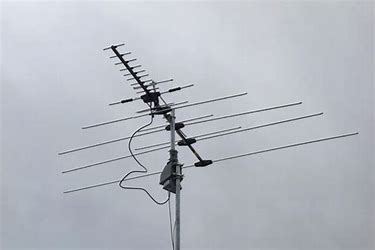After the months of slogging through my remodeling project, I finally freed up enough time to finish this project and get it installed. The antenna has been built since May, but there was always too much to do to get it installed.
Some of my excuses were that I was too busy (which was true). I didn’t want to get on the roof when it was too hot, it seems like this summer has been warm late into the evening. The roof is very steep, so I needed to install roof jacks in order to safely get up to the top. In short, a five minute job took a couple hours to do safely and properly.
I can’t really say how well it works. There is quite a bit better reception just plugging the cable into the receiver. It is my perception that adding the antenna made the reception stronger, of the existing stations I got before the antenna. It seems to mitigate the night/day difference in reception (better at night than during the day).
Given how steep the roof is and that I already removed all of the safety staging, I am going to leave things as is without moving the antenna directionally to test reception. I know that this is kind of a ‘meh’ ending, but I really do think that this made a difference for me because the stations that I like seem to be stable. I guess we will see if seasonal differences mitigated as well.
I thought that I kept all of the receipts, but it seems to have gotten lost in the shuffle. I can give a rough breakdown or guess
- 1/2″ copper pipe, approximately 5′ – already had
- 2, 1/2″ pipe caps – $1 ea
- 1/2″ tee junction box – $3
- 1/2″ conduit – $4
- Antenna adapter -$5
- Simpson 90 – $6
- 2, 1/2″ conduit clamps – $2
- 2, 1″ conduit clamps, $2 ea
- PVC conduit glue – $5
- terminals, screws, clamps, cable, unions – already had
So, I have about $30 into the whole thing. Looking online, the cheapest antenna mounts I could find were $50. That didn’t include the antenna either.
I am interested in building an AM antenna in the future. In this case, I do have specific stations that I want to pick up. But, now that our local football season has been postponed, it is something I will do later as the urgency seems lessoned. I hope that you enjoyed this foray into the science and the mechanics of antennas as much as I did.



Recent Comments